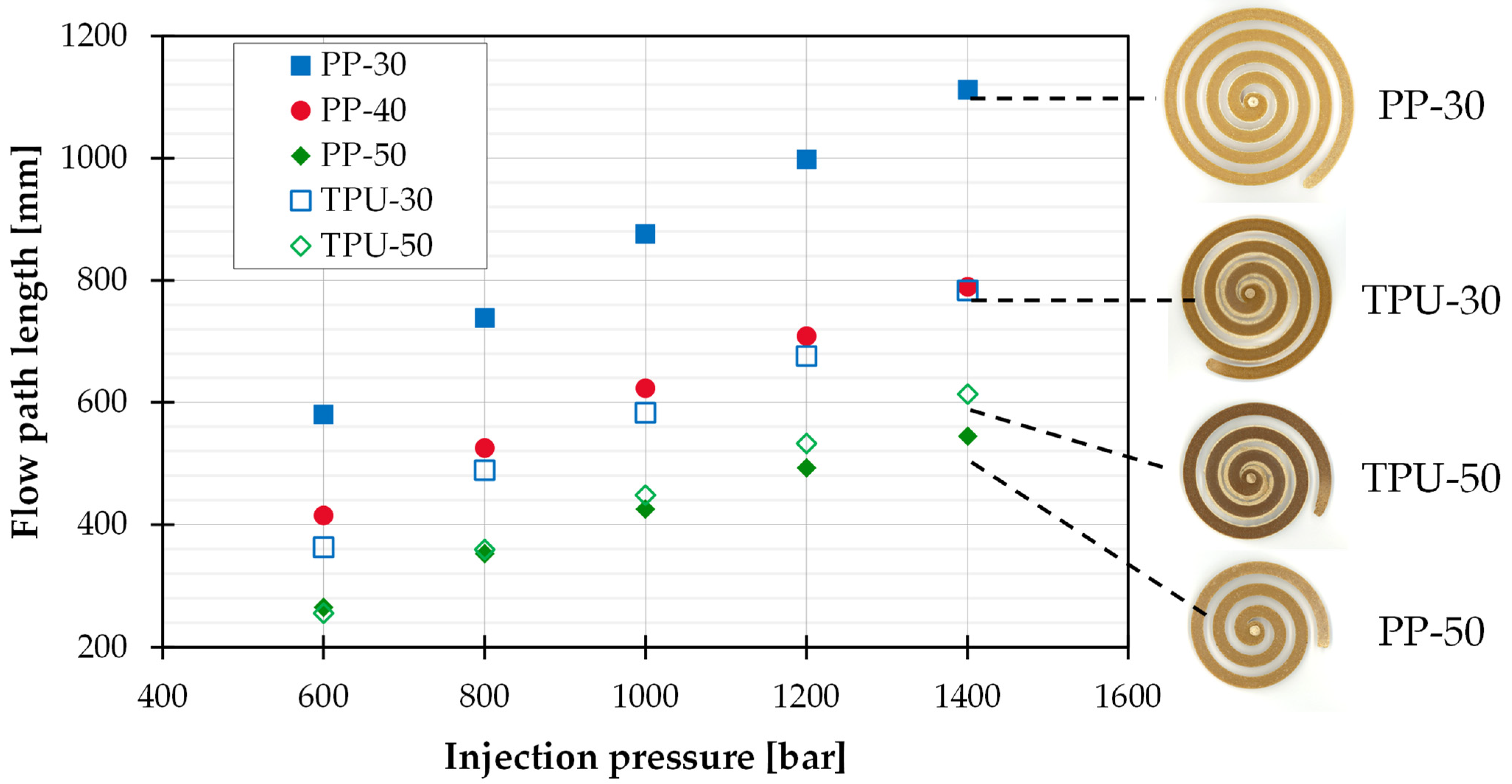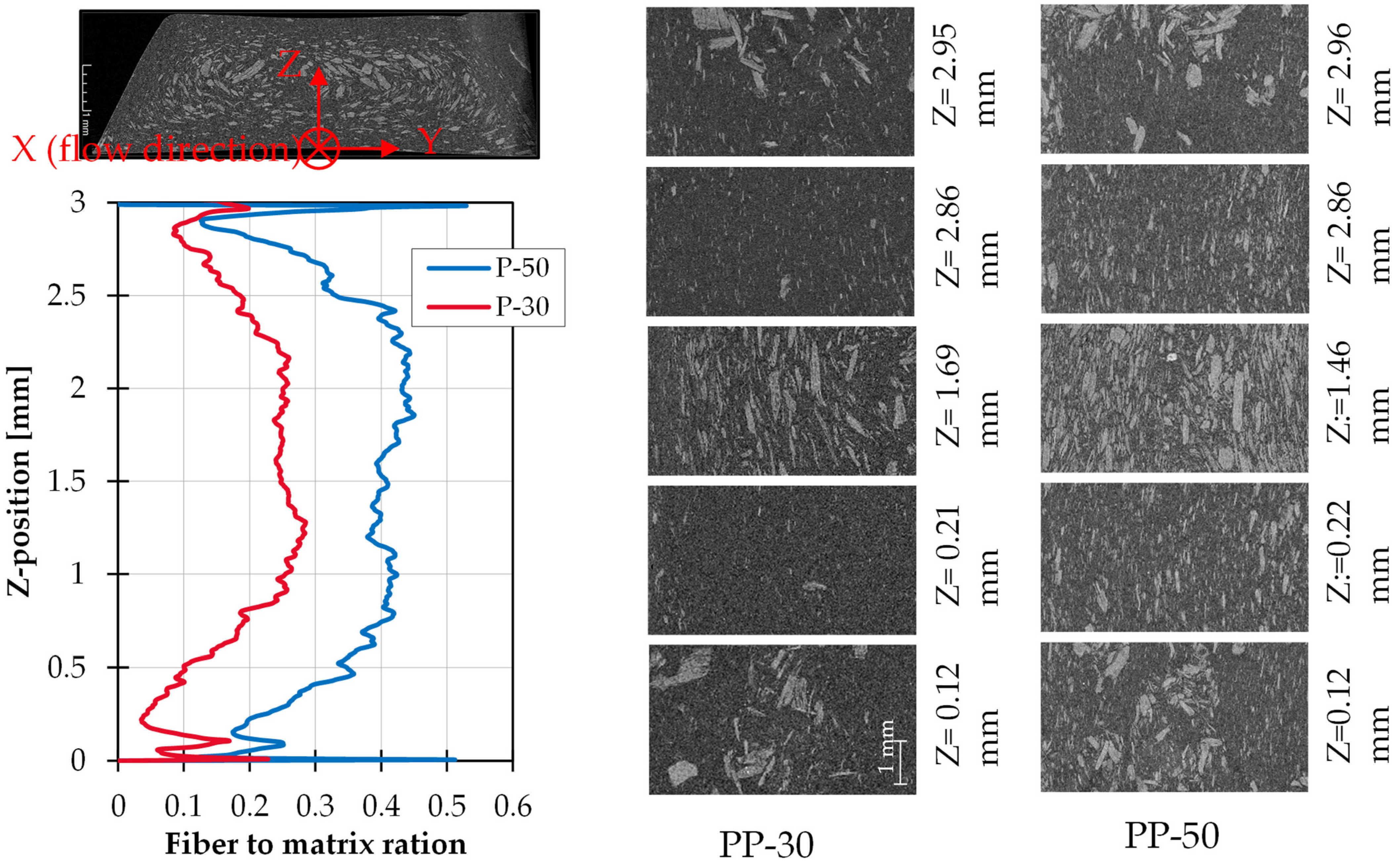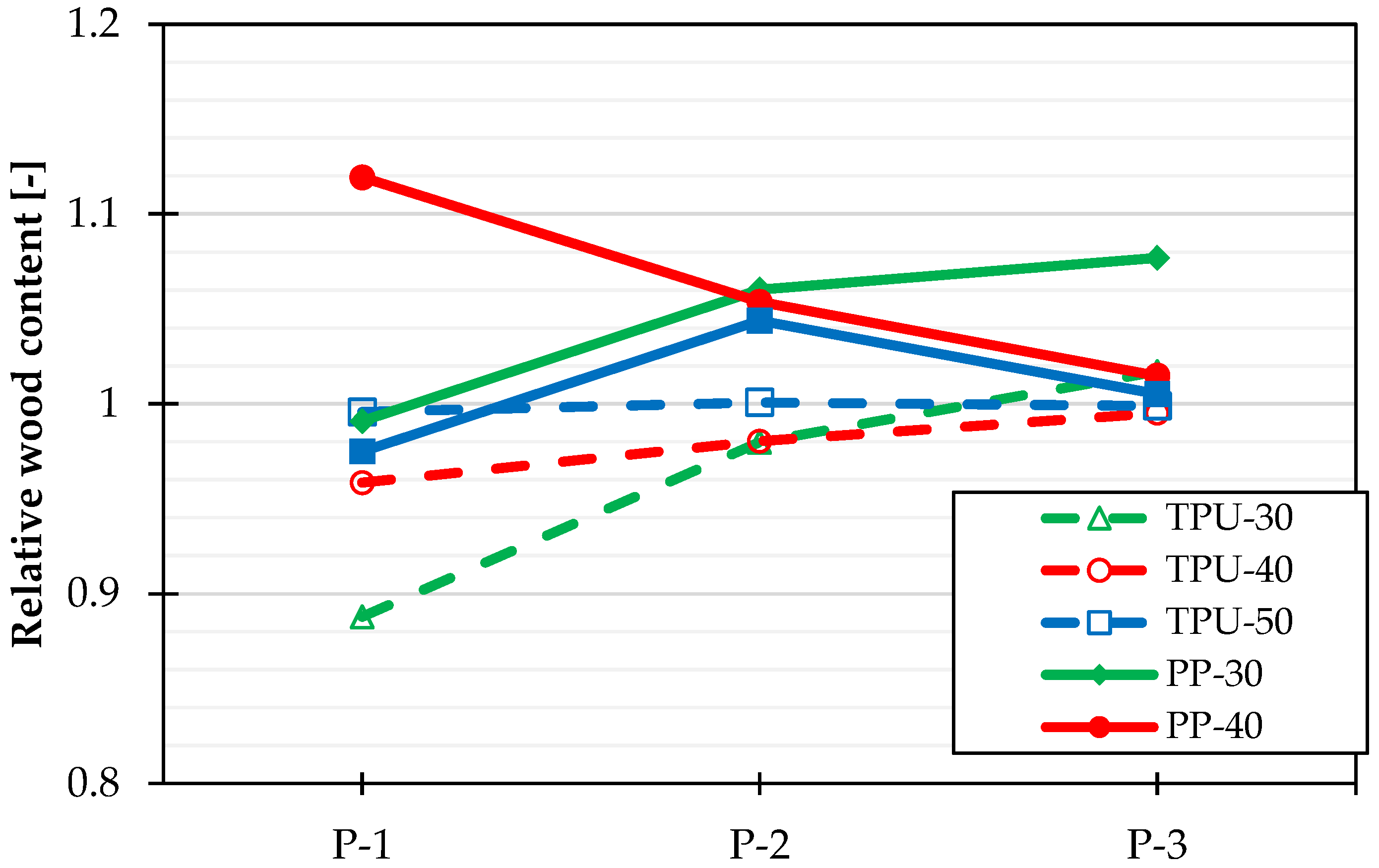Analysis of the Segregation Phenomena of Wood Fiber Reinforced Plastics
Abstract
:1. Introduction
2. Materials and Methods
2.1. Fiber Material
2.2. Matrix Material
2.3. Additives
2.4. Production of Test Specimens
2.5. Soxhlet Extraction
2.6. Computed Tomography
3. Results and Discussion
3.1. Flowability
3.2. Filling Behavior
3.3. Determination of the Wood Content
4. Conclusions
- Edge layer, where large fibers accumulate.
- Narrow sliding layer with low fiber content.
- Core layer with high fiber content.
- Narrow sliding layer.
- Edge layer.
Author Contributions
Funding
Conflicts of Interest
References
- Friedrich, D. Angewandte Bauphysik und Werkstoffkunde Naturfaserverstärkter Kunststoffe: Eine Anleitung für Studium und Praxis; Springer Vieweg: Wiesbaden, Heidelberg, 2021; ISBN 9783658309374. [Google Scholar]
- Klyosov, A.A. Wood-Plastic Composites; Wiley: Hoboken, NJ, USA, 2007; ISBN 978-0-470-14891-4. [Google Scholar]
- Handbook of Wood Chemistry and Wood Composites; Rowell, R.M. (Ed.) CRC Press: Boca Raton, FL, USA, 2005; ISBN 0849315883. [Google Scholar]
- Functional Fillers for Plastics; Xanthos, M. (Ed.) Wiley-VCH: Weinheim, Germany, 2005; ISBN 9783527310548. [Google Scholar]
- Vogt, D.; Karus, M.; Ortmann, S.; Schmidt, C.; Gahle, C. Wood-Plastic-Composites (WPC)—Holz-Kunststoff-Verbundwerkstoffe: Märkte in Nordamerika, Japan und Europa mit Schwerpunkt auf Deutschland Technische Eigenschaften–Anwendungsgebiete Preise–Märkte–Akteure; Nova Institut GmbH: Hürth, Germany, 2006. [Google Scholar]
- Zion Market Research. Wood Plastic Composites Market-Global Industry Analysis: Wood Plastic Composites Market-By Product (Hospitals & Clinics, Polypropylene, and Polyvinyl chloride), By Application (Building & Construction, Electrical, and Automotive), And By Region- Global Industry Perspective, Comprehensive Analysis, and Forecast, 2021–2028. 2020. Available online: https://www.zionmarketresearch.com/report/wood-plastic-composites-market (accessed on 16 August 2022).
- Fachagentur Nachwachsende Rohstoffe e. V. Bioverbundwerkstoffe-Naturfaserverstärkte Kunststoffe (NFK) und Holz-Polymer-Werkstoffe (WPC) 2015. Available online: http://www.fnr.de/fileadmin/allgemein/pdf/broschueren/Broschuere_Bioverbundwerkstoffe-web-V01.pdf (accessed on 18 October 2022).
- Steidl, E.; Sobczak, L.; Pretschuh, C. Monitoring of Injection Molding Tool Corrosion and Effects of Wood Plastic Compound’s Moisture on Material Properties. Int. Polym. Process. 2018, 33, 66–75. [Google Scholar] [CrossRef]
- Funke, C.; Albring, E.; Moritzer, E. Kunststoffe WPC füllt anders. Kunststoffe 2010, 100, 71–74. [Google Scholar]
- Thienel, P.; Hoster, B.; Schröder, T.; Schröder, K.; Kretzschner, J. Duroplastspritzgießen mit Gasinnendruck. Kunststoffe 1993, 83, 91–95. [Google Scholar]
- Castro, J.M.; Macosko, C.W.; Tackett, L.P.; Steinele, E.C.; Critchfield, F.E. Reaction injection molding: Filling of a rectagular mold. J. Elastomers Plast. 1980, 12, 3–17. [Google Scholar] [CrossRef]
- Michaeli, W.; Hunold, D.; Kloubert, T. Formfüllung beim Spritzgießen von Duroplasten. Plastverarbeiter 1992, 43, 42–46. [Google Scholar]
- Duretek, I.; Lucyshyn, T.; Holzer, C. Filling behaviour of wood plastic composites. J. Phys. Conf. Ser. 2017, 790, 12006. [Google Scholar] [CrossRef]
- Schröder, C. Verfahrenstechnische Entwicklung zum Hinterspritzen von Echtholzfurnieren mit Wood-Plastic-Composites (WPC); Shaker: Aachen, Deutschland, 2013; ISBN 978-3-8440-2186-8. [Google Scholar]
- Jesinghausen, S. Rheo-PIV Nichtkolloidaler Suspensionen: Strukturelle Untersuchungen der Strömungsentwicklung in Schlitzdüsen mit Fokus auf Wandgleiten; Shaker: Aachen, Deutschland, 2017; ISBN 978-3-8440-5600-6. [Google Scholar]
- Ramzy, A.Y.; El-Sabbagh, A.M.M.; Steuernagel, L.; Ziegmann, G.; Meiners, D. Rheology of Natural Fibers Thermoplastic Compounds: Flow Length and Fiber Distribution. J. Appl. Polym. Sci. 2014, 131, 39861. [Google Scholar] [CrossRef]
- El-Sabbagh, A.; Ramzy, A.Y.; Steuernagel, L.; Meiners, D. Flowability and fiber content homogeneity of natural fiber polypropylene composites in injection molding. In Proceedings of the Regional Conference Graz 2015, Polymer Processing Society PPS: Conference Papers, Graz, Austria, 21–25 September 2015. [Google Scholar]
- Nikooharf, M.H.; Rezaei-Khamseh, M.; Shirinbayan, M.; Fitoussi, J.; Tcharkhtchi, A. Comparison of the physicochemical, rheological, and mechanical properties of core and surface of polypropylene composite (GF50-PP) plate fabricated by thermocompression process. Polym. Compos. 2021, 42, 3293–3306. [Google Scholar] [CrossRef]
- Moritzer, E.; Richters, M. Characterization of wood-filled thermoplastic polyurethanes for the injection molding process. J. Appl. Polym. Sci. 2021, 138, 50968. [Google Scholar] [CrossRef]
- Moritzer, E.; Richters, M. Injection Molding of Wood-Filled Thermoplastic Polyurethane. J. Compos. Sci. 2021, 5, 316. [Google Scholar] [CrossRef]
- Moritzer, E.; Flachmann, F. Influence of Chemical Blowing Agents on the Filling Behavior of Wood-Plastic-Composite Melts. In SPE ANTEC 2021: The Annual Technical Conference for Plastic Professionals; Society of Plastics Engineers (SPE), Ed.; Curran Associates, Inc.: New York, NY, USA, 2021; pp. 536–540. [Google Scholar]
- Moritzer, E.; Flachmann, F. Process-reliable Injection Molding of Highly Filled Wood-Plastic-Composites (WPC). In Proceedings of the 36th International Conference of the Polymer Processing Society, Montreal, QC, Canada, 26–30 September 2021. [Google Scholar]
- Hegler, R.P.; Mennig, G. Phase separation effects in processing of glass-bead- and glass-fiber-filled thermoplastics by injection molding. Polym. Eng. Sci. 1985, 25, 395–405. [Google Scholar] [CrossRef]







| Parameter | Flow Spiral | Plate | ||
|---|---|---|---|---|
| PP | TPU | PP | TPU | |
| Nozzle temperature [°C] | 180, 190,200 | 190, 200, 210 | 190 | |
| Mold temperature [°C] | 40, 60, 80 | 60 | ||
| Injection pressure [bar] | 600, 800, 1000, 1200, 1400 | 1200 | ||
| Injection volume flow [cm3/s] | 78 = max. | 50 | ||
| Injection volume [cm3] | variable | 17, 34, 51, 68, 85 | ||
| Fiber mass content [wt-%] | 30, 40, 50 | |||
| Property | Arbocel C320 | Arbocel C400 |
|---|---|---|
| Color | Beige | Beige |
| Particle Size | 200–500 μm | 200–600 μm |
| PH-Value (10-% suspension) | 4.5–6.5 | 4.5–6.5 |
| Bulk density | 160–240 g/L | 150–250 g/L |
| Model Parameters | PP-30 | PP-50 | TPU-30 | TPU-50 |
|---|---|---|---|---|
| K | 6035 | 27,120 | 418 | 3226 |
| N | 0.358 | 0.195 | 0.813 | 0.628 |
| Zone 1 | Zone 2 | Zone 3 | Zone 4 | Zone 5 | ||
|---|---|---|---|---|---|---|
| PP-30 | height [mm] | 0.106 | 0.795 | 1.267 | 0.663 | 0.20 |
| PP-50 | height [mm] | 0.10 | 0.706 | 1.627 | 0.481 | 0.075 |
Publisher’s Note: MDPI stays neutral with regard to jurisdictional claims in published maps and institutional affiliations. |
© 2022 by the authors. Licensee MDPI, Basel, Switzerland. This article is an open access article distributed under the terms and conditions of the Creative Commons Attribution (CC BY) license (https://creativecommons.org/licenses/by/4.0/).
Share and Cite
Moritzer, E.; Flachmann, F.; Richters, M.; Neugebauer, M. Analysis of the Segregation Phenomena of Wood Fiber Reinforced Plastics. J. Compos. Sci. 2022, 6, 321. https://doi.org/10.3390/jcs6100321
Moritzer E, Flachmann F, Richters M, Neugebauer M. Analysis of the Segregation Phenomena of Wood Fiber Reinforced Plastics. Journal of Composites Science. 2022; 6(10):321. https://doi.org/10.3390/jcs6100321
Chicago/Turabian StyleMoritzer, Elmar, Felix Flachmann, Maximilian Richters, and Marcel Neugebauer. 2022. "Analysis of the Segregation Phenomena of Wood Fiber Reinforced Plastics" Journal of Composites Science 6, no. 10: 321. https://doi.org/10.3390/jcs6100321
APA StyleMoritzer, E., Flachmann, F., Richters, M., & Neugebauer, M. (2022). Analysis of the Segregation Phenomena of Wood Fiber Reinforced Plastics. Journal of Composites Science, 6(10), 321. https://doi.org/10.3390/jcs6100321






